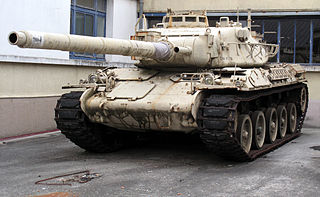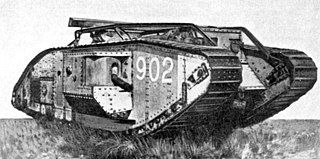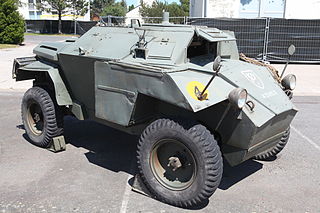History
Conception and design
The very first German armoured cars were special large car or truck chassis adapted to carry a skyward-looking artillery piece for use against observation balloons. These vehicles were collectively known as Ballon Abwehr Kanonen (BAK), though none were taken into large-scale use.
The Belgians were the first to demonstrate the potential of the armoured car in mobile warfare, with the Minerva Armoured Car. German infantry and cavalry were at times distinctly inconvenienced by the hit-and-run tactics employed by the Belgian armoured cars. Having suffered somewhat at the hands of these vehicles, the German Army decided to produce its own armoured car, but without any practical experience they approached the car manufacturing companies Ehrhardt, Daimler and Büssing, and ordered a prototype armoured car from each.
During 1915, the three companies produced the ordered prototypes. In all three cases, the companies chose to ignore the fact that the Belgian armoured cars were little more than converted touring cars, and developed what they perceived to be more suitable vehicles. As a result, all three prototypes were massive vehicles, the largest of which were the Büssing. This vehicle used a 'double-ended' layout that could at least pose a tactically useful high ground clearance. The Ehrhardt and Daimler designs were very similar. Both placed the engine in the front, surrounded by armour, and had a large box-like body at the rear with a turret or cupolas on the top. Both sported a clumsy appearance, and was far too heavy for the effective fulfillment of the operational tasks the German Army demanded of them.
The Daimler and Ehrhardt prototypes were both reliant on the use of double wheels on each side of the rear, and had flanges on the single wheels at the front of the vehicle, in an effort to reduce ground pressure and so enhance the cross-country mobility of the vehicle to a useful degree. All three cars had a crew of eight or nine men, carried an armament of at least three machine guns, and possessed a maximum armour thickness of 9 mm.
Operational history
Along with some improvised conversions, the three prototypes were formed into one unit and sent to first the Baltic and then to the Western Front. Conditions on both fronts were so bad that armoured cars could achieve very little, and the vehicles were eventually deployed on the Russian part of the Eastern Front, where they could at least use their mobility to some effect. It was then that there emerged a need for more vehicles, and so Ehrhardt was contracted to build a further 20 vehicles. These vehicles were 1.72 tons lighter than the original Panzerkraftwagen Ehrhardt 1915. Designated the Panzerkampfwagen Ehrhardt 1917, these vehicles were completed with revised frontal armour. The vehicles were sent to the Eastern Front and served there until the end of the fighting there late in 1917, two of them taking part in Battle of Mărășești against the Romanians, however with little success, as the Germans failed to break the Romanian front. Thereafter they were retained in Germany for internal policing duties. They were so successful in this role that an additional 20 vehicles were ordered and produced in 1919. The E-V/4 was in fact considered just what internal policing required, for its height gave it the capacity to tower over crowds and offer police units better control of riots. E-V/4's were in use almost until World War II.
The demand for armoured cars was so high that by 1918, the Germans were forced to employ numbers of captured armoured cars of Rolls-Royce or other make, and the Ehrhardt vehicles were never around in sufficient numbers. On the Eastern Front the cars were never able to make much of a tactical impression, and so the design is now little known and few operational details have survived. Though many surviving Erhardt E-V/4s were still used by the German police until 1939, none survive today.

An armoured fighting vehicle or armored fighting vehicle (AFV) is an armed combat vehicle protected by armour, generally combining operational mobility with offensive and defensive capabilities. AFVs can be wheeled or tracked. Examples of AFVs are tanks, armoured cars, assault guns, self-propelled guns, infantry fighting vehicles (IFV), and armoured personnel carriers (APC).

A military armoredcar is a lightweight wheeled armored fighting vehicle, historically employed for reconnaissance, internal security, armed escort, and other subordinate battlefield tasks. With the gradual decline of mounted cavalry, armored cars were developed for carrying out duties formerly assigned to light cavalry. Following the invention of the tank, the armored car remained popular due to its faster speed, comparatively simple maintenance and low production cost. It also found favor with several colonial armies as a cheaper weapon for use in underdeveloped regions. During World War II, most armored cars were engineered for reconnaissance and passive observation, while others were devoted to communications tasks. Some equipped with heavier armament could even substitute for tracked combat vehicles in favorable conditions—such as pursuit or flanking maneuvers during the North African Campaign.

The history of the tank begins with World War I, when armoured all-terrain fighting vehicles were introduced as a response to the problems of trench warfare, ushering in a new era of mechanized warfare. Though initially crude and unreliable, tanks eventually became a mainstay of ground armies. By World War II, tank design had advanced significantly, and tanks were used in quantity in all land theatres of the war. The Cold War saw the rise of modern tank doctrine and the rise of the general-purpose main battle tank. The tank still provides the backbone to land combat operations in the 21st century.

The Panzerkampfwagen 38(t), originally known as the ČKD LT vz. 38, was a tank designed during the 1930s, which saw extensive service during World War II. Developed in Czechoslovakia by ČKD, the type was adopted by Nazi Germany following the annexation of Czechoslovakia. With the German Army and other Axis forces, the type saw service in the invasions of Poland, France and the USSR. Production ended in 1942, when its main armament was deemed inadequate. In all, over 1,400 Pz. 38(t)s were manufactured. The chassis of the Pz. 38(t) continued to be produced for the Marder III (1942–1944) with some of its components used in the later Jagdpanzer 38 (1944–1945) tank destroyer and its derivative vehicles.

The AMX-30 is a main battle tank designed by Ateliers de construction d'Issy-les-Moulineaux and first delivered to the French Army in August 1966. The first five tanks were issued to the 501st Régiment de Chars de Combat in August of that year. The production version of the AMX-30B weighed 36 metric tons, and sacrificed protection for increased mobility. The French believed that it would have required too much armour to protect against the latest anti-tank threats, thereby reducing the tank's maneuverability. Protection, instead, was provided by the speed and the compact dimensions of the vehicle, including a height of 2.28 metres. It had a 105 mm gun, firing a then advanced high-explosive anti-tank (HEAT) warhead known as the Obus G. The Obus G used an outer shell, separated from the main charge by ball bearings, to allow the round to be spin stabilized by the gun without spinning the warhead inside which would disrupt jet formation. Mobility was provided by the 720 horsepower (540 kW) HS-110 diesel engine, although the troublesome transmission adversely affected the tank's performance.

AEC Armoured Car is the name of a series of British heavy armoured cars built by the Associated Equipment Company (AEC) during the Second World War.

The Ferret armoured car, also commonly called the Ferret scout car, is a British armoured fighting vehicle designed and built for reconnaissance purposes. The Ferret was produced between 1952 and 1971 by the UK company Daimler. It was widely used by regiments in the British Army, as well as the RAF Regiment and Commonwealth countries throughout the period.

The Daimler Scout Car, known in service as the Daimler Dingo, is a British light, fast four-wheel drive reconnaissance vehicle also used for liaison during the Second World War.

The development of tanks in World War I was a response to the stalemate that developed on the Western Front. Although vehicles that incorporated the basic principles of the tank had been projected in the decade or so before the War, it was the alarmingly heavy casualties of the start of its trench warfare that stimulated development. Research took place in both Great Britain and France, with Germany only belatedly following the Allies' lead.

The Marmon-Herrington Armoured Car was a series of armoured vehicles that were produced in South Africa and adopted by the British Army during the Second World War. RAF Armoured Car companies possessed them, but seem never to have used them in action, making greater use of Rolls-Royce Armoured Cars and other types.

MOWAG is a Swiss company which develops, designs and produces armoured vehicles for military applications in both land-only and amphibious configurations. These vehicles have gross vehicle weights ranging from 9 tonnes to 30 tonnes. The company is owned by General Dynamics, and is now known as GDELS-MOWAG, part of General Dynamics European Land Systems.

The Humber Scout Car was a British light scout car used in the Second World War. It entered service in 1942 and continued in production until 1945. Designed for reconnaissance, and liaison between armoured units, it provided protection only against light arms fire, so was not a front line vehicle. More importantly it was small and fast and could quickly evade trouble. It became the shape format for the post war Ferret armoured car which began production in 1952.

The Panhard 178 or "Pan-Pan" was an advanced French reconnaissance 4x4 armoured car that was designed for the French Army Cavalry units before World War II. It had a crew of four and was equipped with an effective 25 mm main armament and a 7.5 mm coaxial machine gun.

The Autoblindo 40, 41 and 43 were Italian armoured cars produced by Fiat-Ansaldo and which saw service mainly during World War II. Most autoblinde were armed with a 20 mm Breda 35 autocannon and a coaxial 8 mm machine gun in a turret similar to the one fitted to the Fiat L6/40, and another hull mounted rear-facing 8 mm machine gun.

The Pantserwagen M39 or DAF Pantrado 3 was a Dutch 6×4 armoured car produced in the late thirties for the Royal Dutch Army.

The D-442 FUG and D-944 PSZH are the results of Hungarian domestic development of relatively cheap amphibious armoured scout car and armored personnel carrier series. FUG and PSZH were exported with limited success, thus it is also known under its Czechoslovak designation OT-65.

The Büssing A5P was an armoured car produced in Germany during World War I.

The Vickers T-15 light tank, full designation Char Léger de Reconnaissance Vickers-Carden-Loyd Mod.1934 T.15, was a light 4-ton tank of the Belgian Army. They were built by Vickers-Armstrong in the UK to the design of their Light Tank Mark III and outfitted with their armament in Belgium by Fonderie Royale de Canons (FRC) at Herstal. It entered service in 1935, and was used by the Belgian Army during the Battle of Belgium in May 1940. Its main armament was a 13.2 mm Hotchkiss machine gun. The tank was intended as a replacement for the venerable but obsolescent Renault FT. Only 42 were produced.

The Talbot armoured car was a British armoured car built on the chassis of a Clément-Talbot tourer. Built in small numbers to several patterns, the Talbot armoured cars saw service with the Royal Naval Air Service (R.N.A.S.) in the early years of the First World War, serving alongside Rolls-Royce and Delaunay-Belleville armoured cars.




















